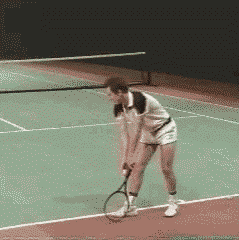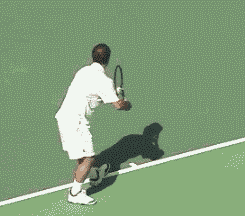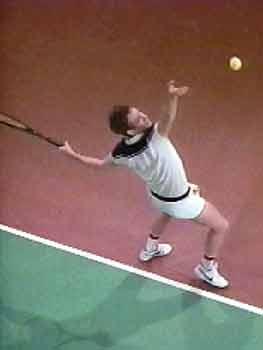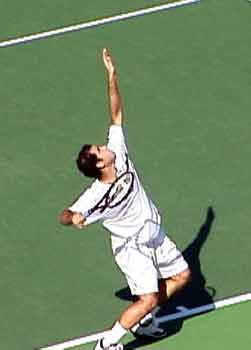<% ns_puts [mkm_getnavbar] %>

Advanced Tennis:
Sampras Serve
Radical Torso Rotation
by John Yandell
In this series we’ve examined some of the
bio-mechanical factors that go into Pete Sampras’s incredible motion,
the virtual perfect swing path, the beautiful, high tossing motion, the
flowing rhythm, and the powerful uncoiling of the
legs. (See part 2, part
3, and part 4).
In this article we turn to the first of several more
advanced factors that are also key to explaining his amazing serving
dominance. The first of these
advanced factors is his hip and shoulder rotation. Pete’s torso rotation
is dramatically higher than other top pros.
Amazingly, this unique factor is rarely, if ever, recognized by
analysts and TV commentators, or in tennis magazines.
|
Pete’s serve, as we have seen, combines great
velocity with heavy spin. Sampras produces a ball that averages 120mph or
more. In addition, he generates an
average spin 2700rpm on his first serve, more than twice as much as other
top pros who serve at the same speed. Producing
this heavy spin, in addition to great velocity, requires incredible racket
head speed (See
Part 1).
The technical elements in his motion we have
previously analyzed all work together to contribute to this. Although few players make them work together as beautifully as
Pete, these more basic factors are shared in part or in whole by other pros.
But Pete’s use of advanced body rotation sets his serve
apart. It takes his motion to a different technical level. His hip and shoulder rotation qualify as a legitimate biomechanical
breakthrough, a breakthrough that can be compared to only one other player
in tennis history: the great John McEnroe.
(Note: The Advanced Tennis Research Project is now
working to film top servers and to quantify the relative importance of
body rotation and all other technical factors in the serve, as well as in
the other strokes. See www.advancedtennis.com)
 |
Although the similarity between Sampras and McEnroe
may not seem obvious to the average viewer, or even to skilled players and
coaches, careful high speed video analysis shows these two great champions
share a unique advantage stemming from their use of body leverage in the
service motion.
McEnroe was the first pro to develop a delivery with
radically increased torso rotation. This
rotation flowed naturally from his distinctive sideways starting stance (See
The McEnroe Serve). With
his rear foot positioned near the edge of the baseline, McEnroe virtually
turned his back to his opponent before his hips and shoulders started
forward to the ball.
The result was something approaching 180 degrees of body rotation through the motion, a phenomenal athletic and technical feat. And, like Pete, McEnroe had the uncanny ability to combine speed and spin, and to produce great serves at the tensest moments in big matches.
Sampras’s motion incorporates only a slightly less
extreme version of this radical rotation.
Compared to most pro players who rotate 90 degrees at most, Sampras
may achieve 140 degrees or more of torso rotation through the course of
his motion. That adds to a
tremendously significant increase in the force going into his delivery.
During McEnroe’s heyday, this bio-mechanical
advance through increased torso rotation was not widely understood or
reported. And the same can be said
of Pete. The role his shoulders and hips play in his serving effectiveness
and consistency is almost completely unrecognized.
This is due in part because the revolutionary bio-mechanics
involved are outside the frame of reference of most analysts, but also
because Pete’s unique starting stance actually disguises his motion, and
makes it harder to see the core similarities with McEnroe.
|
|
|
Both McEnroe and Sampras turn their backs toward their opponents before rotating forward into the motion, radically increasing hip and shoulder leverage. |
|
Here for the first time, we explore the role of
advanced hip and shoulder rotation in Pete’s motion, and how, possibly,
to develop it for yourself. I say “possibly” because we are dealing
with a level of technique that has been perfected by a very small number
of elite players, and apparently only two at the game’s highest level.
Maybe you can remember seeing club players who attempted to copy McEnroe’s motion when he was at the top of the pro game. You’d see a player standing ready to serve in a perfect imitation of McEnroe’s sideways stance, including the rhythmic dropping of the hands and racket that always preceded the start of his motion. <% ns_puts [nsv_get mkm_includes mkm_oldContentFooter_inc] %>



